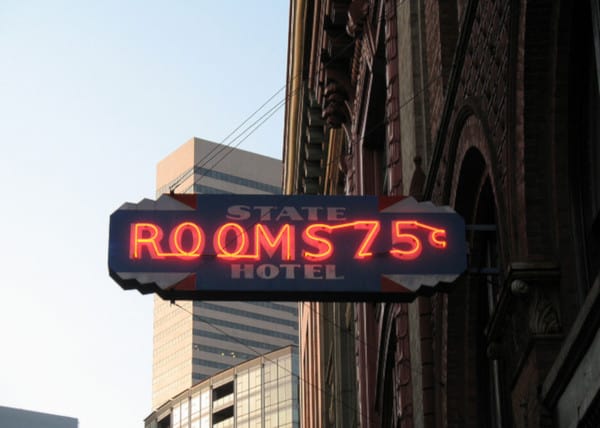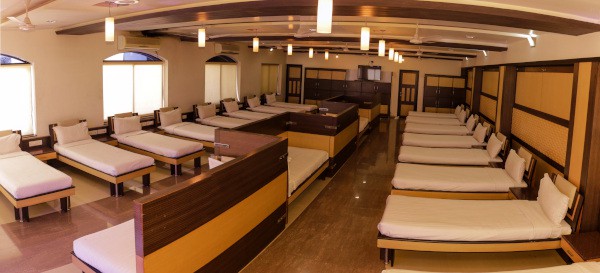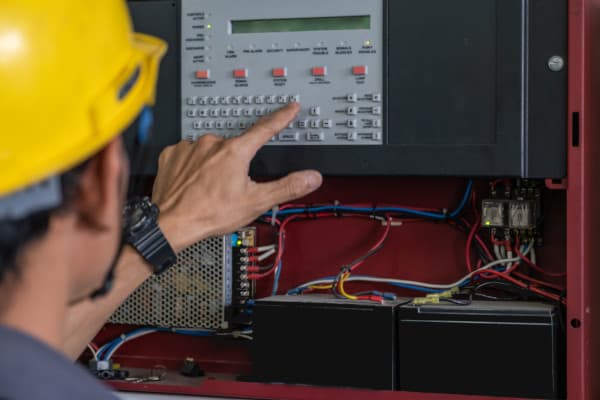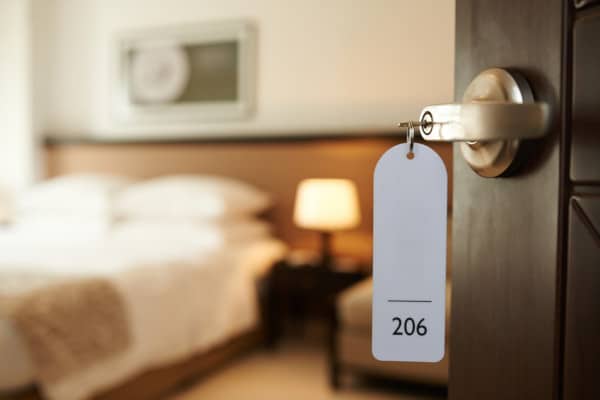Transient occupancies have elevated risk given the number of people they serve — and thus have unique fire sprinkler and alarm requirements
With the rise of remote work opportunities and lodging sites like Airbnb and VRBO, people living the “transient” lifestyle are on the rise. And as a manager or owner of a facility classified as a transient occupancy, there are fire sprinkler and fire alarm needs that must be met to ensure the safety of your guests and meet regulatory requirements.
What exactly is a transient? Let’s define the terms according to the International Fire Code (IFC) and the National Fire Protection Association (NFPA):
From the 2021 edition of IFC
[BG] TRANSIENT. Occupancy of a dwelling unit or sleeping unit for not more than 30 days.
From the 2024 edition of NFPA 101
A.3.3.157. Transients are those who occupy accommodations for less than 30 days.
Before we delve into the specific requirements, it’s necessary to first clearly determine what type of transient or perhaps permanent establishment you have. NFPA and IFC each have several categories and requirements for transient lodging establishments.
The National Fire Protection Association has two broad categories into which transient lodging can fall within, as specified in NFPA 101: Life Safety Code: lodging or rooming house vs. hotel or dormitory.
Lodging or rooming houses are those facilities that provide sleeping accommodations for less than 17 people on either a transient or permanent basis, without independent cooking facilities.
From the 2024 edition of NFPA 101
26.1.1.1* The requirements of this chapter shall apply to buildings that provide sleeping accommodations for 16 or fewer persons on either a transient or permanent basis, with or without meals, but without separate cooking facilities for individual occupants …
A dormitory is slightly different, and larger, at more than 16 people:
From the 2024 edition of NFPA 101
3.3.68* Dormitory. A building or a space in a building in which group sleeping accommodations are provided for more than 16 persons who are not members of the same family in one room, or a series of closely associated rooms, under joint occupancy and single management, with or without meals, but without individual cooking facilities.
Fire protection for hotels also starts with the definition. These settings are also larger, and transient lodging is considered their primary use:
From the 2024 edition of NFPA 101
3.3.157* Hotel. A building or groups of buildings under the same management in which there are sleeping accommodations for more than 16 persons and primarily used by transients for lodging with or without meals.
The International Fire Code, in contrast, classifies these occupancies as residential, or Group R. These can be either Group R-1, R-2, or R-3. The IFC also utilizes the term “boarding house” to apply to a broad range of occupancies.
From the 2021 edition of the IFC
[BG] BOARDING HOUSE. A building arranged or used for lodging for compensation, with or without meals, and not occupied as a single-family unit.
To determine which of these categories your facility may fall into, there are three things you must know:
- Are the occupants transient or permanent?
- How many people are there accommodations for?
- What type of structure is this?
If the space primarily serves a transient population and contains sleeping units for more than 10 occupants, it will be defined as a Group R-1 occupancy. When the facility primarily serves a non-transient, or permanent, population, then the structure will most often slide into the Group R-2 category. Group R-3 occupancies are those boarding houses and congregate living facilities with sleeping accommodations of more than 16, for non-transient persons. If the boarding house or congregate living facility houses 10 or fewer occupants on a transient basis, then they are classified as a Group R-3 as well.
After you have correctly defined the type of establishment according to the model fire codes, it’s time to look at the fire protection requirements and exceptions. Regardless, all types will require some form of fire alarm and fire sprinkler system. What may change involves some exceptions, installation standards, and levels of coverage.

Fire alarm and sprinkler requirements for lodging or rooming houses
If an existing lodging or rooming house has a smoke detection system that is properly maintained and tied to a fire alarm box that can activate the system, then a complete fire alarm system does not need to be installed. Some exceptions and allowances within codes allow the installation of only smoke detectors, or only a single manual pull station. However, all new construction of lodging and rooming houses will require a full fire alarm system. A complete, or full, system would meet all the requirements of NFPA 72: National Fire Alarm and Signaling Code, which would typically include the installation and interconnectivity of pull stations, detectors, and horns/strobes.
A fire sprinkler system is also required throughout all new lodging and rooming houses. Codes allow for the installation of these systems to be in accordance with either NFPA 13, NFPA 13R, or NFPA 13D:
● NFPA 13: Standard for the Installation of Sprinkler Systems
● NFPA 13D: Standard for the Installation of Sprinkler Systems in One- and Two-Family Dwellings and Manufactured Homes
● NFPA 13R: Standard for the Installation of Sprinkler Systems in Low-Rise Residential Occupancies
An NFPA 13R system can only be utilized if the lodging or rooming house is four or fewer stories in height and is no taller than 60’ above grade. Due to the fact that the expected fire exposure and its challenge to the fire sprinkler system in lodging and rooming houses are no different than that of a single-family residence, an NFPA 13D system would also be permitted.

Fire alarm and fire sprinkler requirements for dormitories and hotels
New dormitories and hotels require a fire alarm system. Functions of the fire alarm system specific to dormitory and hotel occupancies include requirements for the following features:
- Manual fire alarm box, or pull stations.
- Manual fire alarm box located at a continuously supervised location.
- Required to be initiated by activation of the fire sprinkler system.
- Visible notification appliances to accommodate the hearing-impaired.
- Smoke alarms required within every guest room.
This section of the code allows a “positive alarm sequence” to be utilized.
From the 2022 edition of NFPA 72
3.3.213 Positive Alarm Sequence. An automatic sequence that results in an alarm signal, even when manually delayed for investigation, unless the system is reset.
Fahad Khan of the fire protection firm Jensen Hughes explained the positive alarm sequence:
“It provides an alarm delay of up to 180 seconds if trained personnel acknowledge the alarm at the control panel within 15 seconds. This action provides the responding personnel time to investigate an alarm before evacuating a building.
This delay is only permitted for automatic detection devices. If a second automatic fire detection device is actuated during the 180-second investigation phase, all normal building and remote signals shall be automatically activated. This is very common in large assembly occupancies where positive alarm sequence is used to reduce the number of unwanted or nuisance alarms. Evacuation of thousands of occupants, for instance, during a major spectator event is highly undesirable if caused by a nuisance alarm.”
For dormitories having an occupant load of more than 100 persons, mass notification may be required. Determination for this type of system will be based on a risk analysis.
From the 2022 edition of NFPA 72
3.3.97.1.3 In-Building Mass Notification System. A system used to provide information and instructions to people in a building(s) or other space using intelligible voice communications and including visual signals, text, graphics, tactile, or other communication methods.
Fire sprinkler systems are required to be installed throughout the building. As with lodging and rooming houses, an NFPA 13R system can be utilized if the building is four or fewer stories in height and is no taller than 60’ above grade. Only quick response or residential type sprinkler heads are permitted to be used within the guest rooms.

Transient establishments require integrated testing
A lodging facility, rooming house, dormitory, or hotel all require integrated testing. Integrated testing, introduced in the 2018 edition of the Life Safety Code, is needed to ensure that all functions of a variety of intertwined building systems take place during system activation.
From the 2024 edition of NFPA 101
28.7.8 Integrated fire protection and life safety systems shall be tested in accordance with 9.11.4.1.
Integrated fire systems are those fire protection and life safety systems that “are required to operate together as a whole to achieve overall fire protection and life safety objectives.” (NFPA 4) An example of an integrated system might be a fire alarm, fire sprinkler, elevator recall, and smoke control. When a fire is detected, each of these items has a specific code-required function to perform. Integrated testing ensures that these systems all work flawlessly together.
From the 2024 edition of NFPA 101
9.11.4.1 Basic Testing. Where required by Chapters 11 through 43, installations involving two or more integrated fire protection or life safety systems shall be tested to verify the proper operation and function of such systems in accordance with 9.11.4.1.1 and 9.11.4.1.2.
International Fire Code requirements for Group R occupancies
The IFC requires the installation of a fire sprinkler system throughout all Group R occupancies. If the facility is a Group R-3, the IFC permits the installation of a less complex NFPA 13D fire sprinkler system vs. an NFPA 13 version.
From the 2021 edition of the IFC
903.2.8 Group R. An automatic sprinkler system installed in accordance with Section 903.3 shall be provided throughout all buildings with a Group R fire area.
903.2.8.1 Group R-3. An automatic sprinkler system installed in accordance with Section 903.3.1.3 shall be permitted in Group R-3 occupancies.
Fire alarm systems are also required to be installed throughout all Group R-1, and Group R-2 occupancies — though with some exceptions, including size and the presence of fire partitions, sprinkler systems, and ways of exiting the building quickly:
From the 2021 edition of IFC
Group R-1
907.2.8. Exceptions:
1. A manual fire alarm system is not required in buildings not more than two stories in height where all individual sleeping units and contiguous attic and crawl spaces to those units are separated from each other and public or common areas by not less than 1-hour fire partitions and each individual sleeping unit has an exit directly to a public way, egress court or yard.
2. Manual fire alarm boxes are not required throughout the building where all of the following conditions are met:
2.1. The building is equipped throughout with an automatic sprinkler system installed in accordance with Section 903.3.1.1 or 903.3.1.2.
2.2. The notification appliances will activate upon sprinkler water flow.
2.3. Not fewer than one manual fire alarm box is installed at an approved location.
Group R-2
907.2.9. Exceptions:
1. A fire alarm system is not required in buildings not more than two stories in height where all dwelling units or sleeping units and contiguous attic and crawl spaces are separated from each other and public or common areas by not less than 1-hour fire partitions and each dwelling unit or sleeping unit has an exit directly to a public way, egress court or yard.
2. Manual fire alarm boxes are not required where the building is equipped throughout with an automatic sprinkler system installed in accordance with Section 903.3.1.1 or 903.3.1.2 and the occupant notification appliances will automatically activate throughout the notification zones upon a sprinkler water flow.
3. A fire alarm system is not required in buildings that do not have interior corridors serving dwelling units and are protected by an approved automatic sprinkler system installed in accordance with Section 903.3.1.1 or 903.3.1.2, provided that dwelling units either have a means of egress door opening directly to an exterior exit access that leads directly to the exits or are served by open-ended corridors designed in accordance with Section 1027.6, Exception 3.
Additionally, smoke alarms are required to be installed in all Group R facilities at the specific locations listed in IFC 907.2.11:
- In sleeping areas.
- Outside of sleeping rooms and areas.
- On each floor within the room or sleeping area.
- In each room in the path of egress from the sleeping area.
Know the standards and codes governing fire protection for hotels, dormitories, and other transient occupancies — and stay safe and compliant
Awareness of the requirements and proper installation and maintenance of fire protection systems can help ensure the safety of transient dwellers who patronize your lodging, rooming house, hotel, or dormitory.
Do you need fire sprinkler system components for your building? Browse QRFS’s wide selection. You can also contact us at 888-361-6662 or support@qrfs.com with any questions, or if you need something that isn’t listed online.
This blog was originally posted at blog.qrfs.com. If this article helped you, check us out at Facebook.com/QuickResponseFireSupply or on Twitter @QuickResponseFS.




Architect for a very important and very unaltered historic house circa 1831. The owners want to have as bread and breakfast for potentially six accommodation rooms or could be less, also house museum tour and special events for less than 50 persons in basement. Masonry bearing walls, wood wall partitions, floors and roof.
Could you provide assistance?
Allen — For code and occupancy-specific system application questions like this, you can consult a fire protection installer/designer, or you can try our Ask a Fire Pro service at the higher price tier. Click the link to submit your question with some information about your building, and a fire protection professional can provide an overall answer based on standards and codes. Please be specific about the assistance/question you need/have. For example, “is a sprinkler system needed, etc.” Thanks!
Does a sleeping area in a fire department with less than 5 people have to have a sprinkler system ?
Randy – For code questions like this, you can try our Ask a Fire Pro service. Click the link to submit your question with some information about your building, and a fire protection professional will provide an answer based on standards and codes. Our pros include AHJs, contractors, engineers, and code experts with 150+ years of combined experience!
Is it a requirement that the fire alarm activation system in a 3 story hotel contact a outside emergency department like a fire department directly that an alarm went off. Or can the owners of the hotel, who live there contact the fire department if they think its necessary. NYS
Jerome – For code interpretation questions like this, you can try our Ask a Fire Pro service. Click the link to submit your question with some information about your building, and a fire protection professional will provide an answer based on best practices, standards, and codes. Our pros include AHJs, contractors, engineers, and code experts with 150+ years of combined experience!
Question: What are the requirements for what I guess you would call a motor inn. The building is a row of rooms, all on the first floor. These rooms are two queen beds maximum. They would be rented out on a weekly/monthly basis. I have found the IBC to be too complicated for me.
Thank you.
Rachel — For system and code-requirement questions like this, you can try our Ask a Fire Pro service. This is a multi-part question that would require the “Ultimate Pro” package. Click the link to submit your question with some information about your building and system, and a fire protection professional will provide an answer based on best practices, standards, and codes. Our pros include AHJs, contractors, engineers, and code experts with 150+ years of combined experience!
I have a 4 story building but less that 1,000 sq/ft, second and third floors are two door apartments do I need a sprinklers?
Maria — This depends on specific factors, and your best bet is to contact your local building/permitting department or fire marshal.
Hello, Thank you for your great explanation above. I’m am still a bit uncertain of one specific example that I’d like to share with you. I am a contractor… not a Fire Alarm, nor Electrical expert. I have a question about Smoke Detectors within the guestrooms of a a 20-story hotel. A 20-story “historic” office building was recently converted to a hotel. All interior walls, mechanical, electrical shafts, etc were gutted down to the bare structure. The only thing primarily untouched was the facade and the lobby levels. upon Substantial Completion, the Building Inspector and Fire Dept issued a Temporary Certificate of Occupancy allowing the hotel to open to the public… with the provision that the remaining work (Lobby Restaurant) must be complete prior to issuing the final Certificate of Occupancy. A few weeks later, the Health Inspector came to do a courtesy walk of the restaurant. She also inquired about the hotel and inspected several rooms. Observing that none of the guestrooms had smoke detectors, she instructed the hotel to stop operating and issued a notice of violation. There was a bit of a squabble between her and the Fire Dept and Building Dept. The hotel Operations Team was stunned and inquired with the City. The contractor looked into this and found that the approved Fire Alarm plans did not show smoke detectors on the drawings, however the City’s “Approval Stamp” stated that smoke detectors are required in each room. The General Contractor went out to several Home Depot locations around the City to find over 250 battery-operated smoke detectors. They mounted them to the ceiling of each guestroom. After completing the work, they notified the Health Inspector who came out to inspect the rooms and detectors. She was satisfied. The Building Inspector issued the full Certificate of Occupancy. So the hotel has battery-operated smoke detectors in each room and living area adjacent to a bedroom. None of them are hard-wired. None of them are integrated into the Fire Alarm System. This building has Fire Sprinklers throughout the corridors and the guestrooms. It has Smoke Detectors/Fire Alarms in the Corridors outside the guestrooms, but nothing integrated inside. The elevators and other alarm devices are integrated into Fire Alarm System, but none of the guestroom smoke detectors are integrated. All are battery-operated. This seems like a big problem to me. Is this hotel in compliance with the IBC and NFPA, etc? Imagine if the maintenance engineer forgot to replace the 9v battery every six months… and the smoke detector starts beeping in the middle of the night… waking up the guest. The guest climbs onto a chair and removes the battery. No more beeping smoke detector. Then sometime in the future, there’s a fire. The alarm doesn’t activate because there is no battery. The guest dies from asphyxiation. Who should I notify about this potential hazard. the hotel company already knows, yet they are doing nothing about it.
Wyatt — Thanks for reading and the detail provided here. The nature of the question and the variables involved require a fire protection/code professional to spend some time assessing the situation and reviewing the appropriate codes/standards to provide an accurate and well-researched answer. We have a paid service for these typed of situations: QRFS Ask a Fire Pro. There, you can provide your info and these details, and a qualified pro (current AHJ, former contractor, and NFPA committee member) can assess the situation and provide an accurate and relevant answer. Thank you!